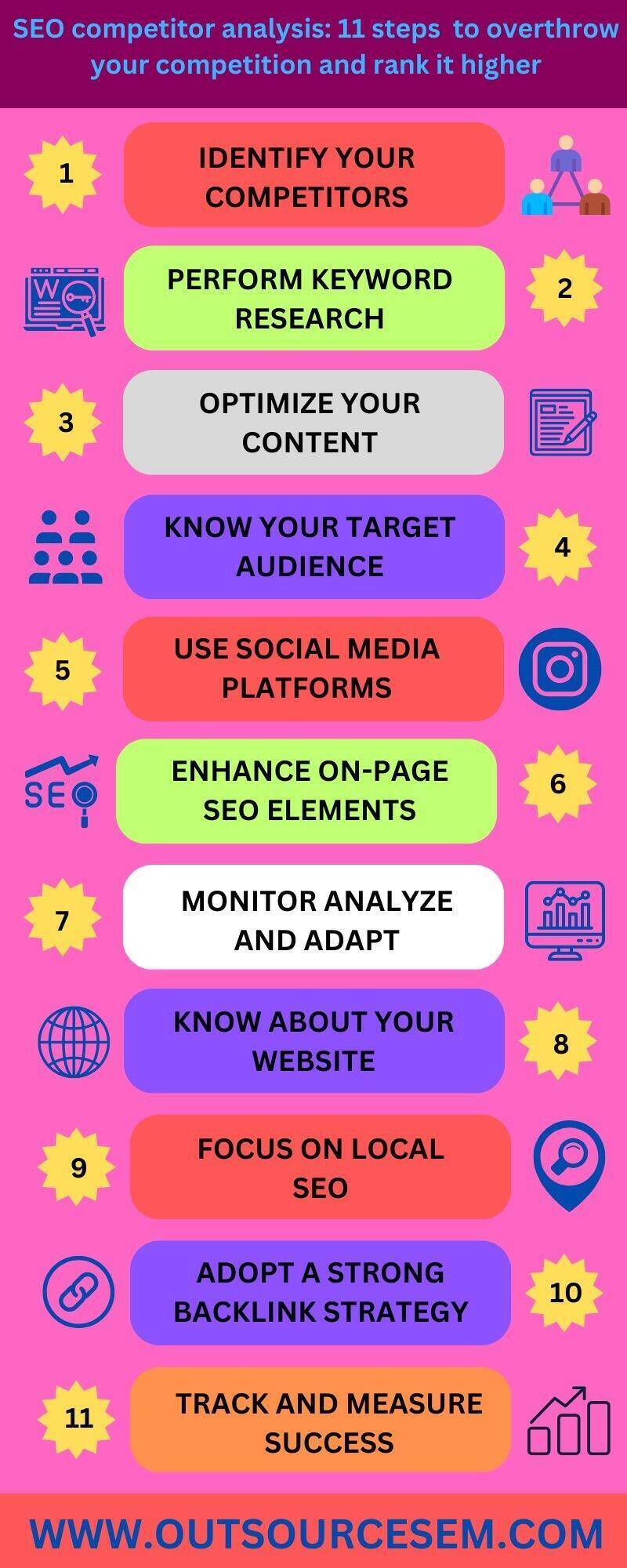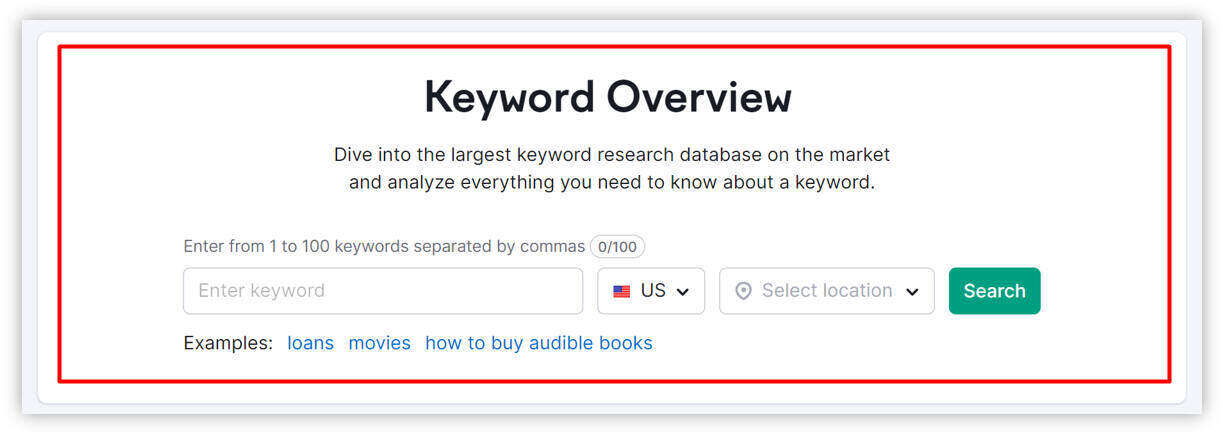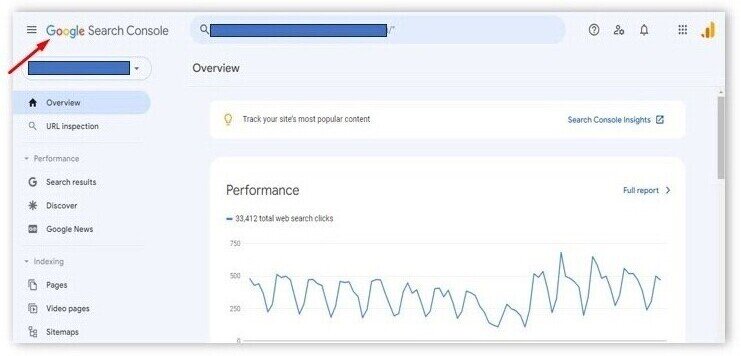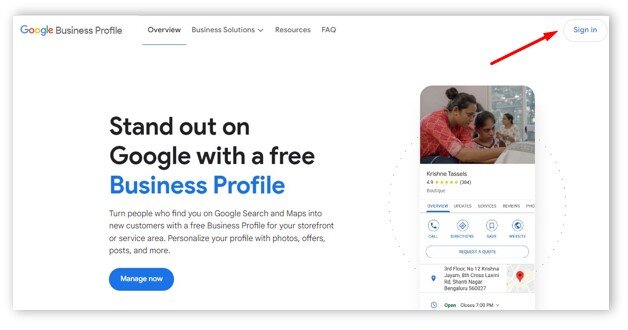Reaching a prime spot on search engines is a critical goal for businesses seeking to enhance their online visibility and attract more traffic. Digital marketers must continuously implement SEO strategies leveraging advanced SEO tools and techniques to ensure success in the ever-evolving digital landscape. Mastering the art of website ranking on search engines is an ongoing endeavor that encompasses all facets of online marketing, enabling businesses to maintain a competitive edge. By following a comprehensive process, industries can enhance website visibility and improve search engine rankings, thereby surpassing competitors in both the short and long term. In this blog, we will explore the concept of competitor SEO analysis and outline the necessary steps to elevate your ranking above the competition.
What is SEO competitor analysis?
SEO competitor analysis is a process that helps you in identifying the strengths and weaknesses of your competitors who are running the same business as you. It will enable you to adopt marketing strategies by knowing your competitors' strategies to gain more traffic, conversions, and leads for your business. Monitoring your competitors is essential as it allows you to catch up with your competitors and outperform them in the long run. Competitor SEO is also critical from all perspectives businesses need to work on, like keyword research, optimizing content and images, and adding videos, links, etc. There are various competitor analysis tools that are used by businesses that help your website rank higher on SERP and thereby staying on the top among the SEO trends.
Steps to overthrow your competition and rank higher

1. Identify your competitors: Analyze the competitors that stand at par with your industry. This process shows their strengths, weaknesses, and the central areas where you can outperform them. You can start by performing a detailed analysis of your competitors. This covers areas like keywords, which keywords they are targeting, what SEO tools they use, and much more. Identifying competitors is challenging as there are hundreds of industries with the same niche as yours. Hence, businesses must carefully scrutinize the industry and the competitors who can dominate the digital marketing world in the long run. Tools like SEMrush, Ahrefs, etc., will enable you to identify the best competitors. Further, after placing your top competitors, please take the next step of diving into each one’s online presence and analyze what makes them successful.
2. Perform keyword research: Develop a strong keyword strategy by identifying high-volume keywords relevant to your businesses. Various tools like Google Keyword Planner and UberSuggest are used to select keywords with high search volume and low competition. Analyze where your competitors stand regarding keyword targeting, search volumes, and current rankings. The other important factor to consider is recognizing long-tail keywords that might have low search volumes but are easy to rank. Performing competitors' keyword research will help analyze your competitor's strategy and optimize your content accordingly, thus increasing the traffic for your website.

3. Optimize your content: Content is king, so writing unique and engaging content will give you a competitive advantage in the short and long run. For this, you must identify your niche and write entertaining and valuable content that matches your target keywords and niche and addresses your audience's needs and interests. Then, optimize your content for both users and search engines by adding links, images, videos, etc., to quickly drive traffic and bring conversions to your website.
Understanding your competitor's content strategy is the most crucial part of competitors' analysis, which involves how your content should be written, keeping in mind the SEO marketing practices. Also, check out for the constant updates brought out by Google and then embrace changes as per the algorithm. These rules are that they should match users' search intent and should solve their queries in the best possible way. A business should know that high-quality content is necessary for outranking SEO competitors.
4. Know your target audience: Competitors' SEO is essential in knowing your target audience, as whatever content a website presents is presented to the audience. Because of the audience, content can be ranked, and visitors are the only ones who can increase traffic. So, optimizing content by analyzing your competitors is very important for your target audience. SEO of websites is done to enhance website performance, and this can only be done when you optimize the content both for the search engines and the target audience. So, when you analyze your competition, identifying your target audience is a prerequisite criterion.
5. Use social media platforms: Social media marketing is critical when you want to promote your content. Competitor analysis also involves how a business comes to know whether they use social media platforms and channels to promote their business. Choosing social media platforms to boost brand awareness is essential in today's landscape, given the widespread activity on platforms such as Facebook, YouTube, Instagram, LinkedIn, Twitter, and more. Sharing content on these platforms can yield significant benefits for your brand. Social media auditing is necessary as it helps evaluate your competitor's social media presence, helps identify platforms where they excel, and strategically establishes your brand on those platforms, attracting content and engagement.
6. Enhance on-page SEO elements: Enhance your on-page elements, including title tags, meta descriptions, headers, and image alt text. Ensure that each page is well-optimized to provide a great user experience and convey the relevance of your content to search engines. Site structure assessment is another aspect of competitor analysis, which features evaluating your competitors' site structures. Optimize your own site structure for user experience and search engine crawlability, ensuring a competitive advantage. Improving on-page SEO elements involves optimizing title tags, descriptions, headers, images, and alt text. This enhances site responsiveness and speed, ensuring an exceptional user experience.
7. Monitor analyze and adapt: Keep a close eye on your competitors' actions and adjust your policies to stay ahead in the market. To effectively adapt to competitor changes in the digital marketing world, you have to monitor the performance of your competitor's websites to make the required SEO changes in your business. You should be regularly updated with the latest trends and adopt the changes required for business expansion. Analyze your competitors' content, strategies, and areas where they may be lacking to exploit opportunities for improvement. Stay updated on industry trends and forecast changes in competitor tactics to actively adapt your strategies. The business landscape constantly changes, so businesses must regularly monitor market trends, customer preferences, and their competitors' strategies. Be ready to adapt and modify your SEO tactics as per the market research and respond to shifts in the digital landscape. Businesses need to stay vigilant with ongoing competitor analysis. Monitor changes in their strategies and adapt your approach to maintain a competitive advantage according to search engine algorithms.
8. Know about your website: You must understand your own website very well. Start with evaluating your existing SEO rankings, pointing out any weaknesses, and determining how ahead in the future you would like your business's search engine standing to progress. So before you analyze your competitor's website, ensure you have enough knowledge about your website. To compare your website with your competitor's websites, you will need the following metrics and they are:
A. Your competitor's keywords on which your competitor's business is ranking and you want to rank your business.
B. Your ranking position and their ranking position on Google. Your site visitor traffic: how much you collect, where it comes from, how well it converts.
C. Your page metrics from all social media platforms where you advertise your business.
D. What exactly does your niche contain and theirs?
E. Who is your target audience?
Also, various SEO tools like Google Analytics, Google Search Console, and SEMrush are used to collect traffic data, backlink analysis, keyword ranking data, and so on, as well as to assess your website and compare it with your competitors. Thus, evaluating your website's performance is an essential first step in implementing a successful competitor SEO strategy. Optimizing performance through keyword analysis, conversion rate optimization, social media metrics, and target audience analysis is important for gaining a competitive advantage.

9. Focus on local SEO: If your business targets a local audience, implement local SEO strategies. Optimize your Google My Business profile, promote customer reviews, and ensure name, address, and phone number information are present across social platforms. Local SEO should be prioritized if your business is based in a physical place. This can be useful for drawing in new clients that live within your vicinity and competing with nearby businesses. The optimization for localized SEO improves a site’s general rankings because many users add geographic keywords as part of their search terms.
Conduct a thorough survey on their local SEO and attempt to use similar practices therein. Some of these are using location-specific keywords in the content, claiming and optimizing your Google My Business listing and earning links from local sites. Local SEO is essential for listing locally and comparing your business with competitors. Often, customer reviews attract customers and boost your local search rankings.

10. Adopt a strong backlink strategy: Your competitor’s backlinks are one of the key ranking factors in SEO and will provide you with helpful information. Develop a healthy backlink strategy by earning high-quality, authoritative backlinks from a high-authority website. Reach out to industry influencers, engage in guest posting, and use social media platforms to enhance your content, attracting natural backlinks. Backlinks from websites with high authority and relevant content boost ranking. Find out whether it is a high-quality website or not.
Further, check the anchor texts of these backlinks, which should contain the primary keywords. Therefore, you will know what keywords most competitors use to get links and use this information to build better backlinks. So, analyzing your competitor’s backlinks and utilizing that information to design a better backlink strategy for your website is one of the essential SEO strategies. In addition, focus on developing unique and engaging content that will generate good-quality backlinks, as it will improve your SEO and position your website as an authority in your domain. You can further discover the backlink profiles of your competitors. Identify high-quality backlinks and develop a strategy to gain better links to enhance your website’s authority.
.jpg)
11. Track and measure success: Evaluate your performance and monitor the effectiveness of your competitor’s SEO efforts to ensure continued success in outperforming your competition. Tracking success and measuring effectiveness are crucial aspects of competitor analysis. Utilize SEO metrics and performance evaluation to assess the impact of your strategies. Analyze critical indicators such as search engine rankings, website traffic, and conversion rates to track and measure your progress. Regularly monitor and adjust your tactics based on data-based information for maximum results. Establish key performance indicators such as organic traffic, keyword rankings and conversion rates that align with your SEO goals to measure success. Utilize analytics tools to generate reports and review performance data, redefining your strategy based on competitor analysis.
Conclusion
Achieving mastery in SEO competitor analysis demands a continuous and dynamic approach, by implementing strategic thinking and comprehensive tactics. By conducting in-depth competitor analysis, optimizing content and on-page SEO elements, implementing a robust backlink strategy, you can outperform your competitors and secure superior rankings in search engine results.
By following these foremost approaches, you can surpass your competitors and ensure long-term success and growth for your business. You can also outsource SEO services from a digital marketing agency that uses these strategies. Further by hiring a digital marketing experts you can avail various services like SEO copywriting services, SEO detox and penalty removal, prepare SEO reports, conduct SEO audit, content marketing, link building and various other services for your client. Also, by hiring our top SEO agency you can take advantage of various other online marketing services for your business like lawyer SEO, small business SEO, HVAC SEO, electrician SEO, appliance repair SEO and etc. All these services can increase your website traffic, brand visibility and profitability in the future.
- SEO competitor analysis: Discover your competitor’s keywords
- How to do an SEO competitor analysis + free template
